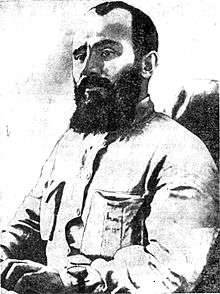Georgi Atarbekov

Georgiy Aleksandrovich Atarbekov (Russian: Георгий Александрович Атарбеков), born Atarbekyan (December 2, 1892 – March 22, 1925) was an Armenian Bolshevik and Soviet security police official.
Biography
Born in Echmiadzin (near Yerevan, Armenia), then part of the Russian Empire, Atarbekov joined the Russian Social Democratic Labour Party in 1908 and studied at the Moscow University from 1910 to 1911. During the Russian Revolution of 1917 and the ensuing Russian Civil War, he took part in the Bolshevik attempts at gaining footholds in Alexandropol and Sukhumi. He then worked for the North Caucasus Cheka and took part in fighting with the White Russian forces and the Muslim insurgents in the region. Afterwards he served as a VeCheKa plenipotentiary in Kuban, and Baku; then chaired a revkom for northern Armenia and finally, after the final sovietization of the Caucasus, received a post of People's Commissar for Post and Telegraph in the Transcaucasian government.[1]
An ally of Joseph Stalin and – in the words of the modern British scholar Donald Rayfield – "Stalin's favourite killer of the Caucasus",[2] Atarbekov was one of those responsible for repressions during the Russian revolution and the civil war. Thus, he machine-gunned a train-load of Georgian medical stuff returning to Georgia from the World War I fronts; and organized mass killings in prisons in Pyatigorsk and Armavir.[3]
In March 1925, together with Solomon Mogilevsky and Alexander Myasnikov, Atarbekov flew on a plane, from Tiflis, to meet Trotsky who was in convalescence in Sukhum.[4] But the plane caught on fire in the air.[2] According to one version, a young Georgian airman, who was piloting the plane crashed deliberately, killing himself and his high-ranking passengers to avenge for the heavy-handed suppression of the 1924 revolt in the Georgian SSR.[5] Another hypothesis suggests Lavrenty Beria’s role in arranging the catastrophe.[6]
References
- ↑ (Russian) Атарбеков Георгий Александрович. Great Soviet Encyclopedia
- 1 2 Rayfield, Donald (2004), Stalin and His Hangmen: An Authoritative Portrait of a Tyrant and Those Who Served Him, p. 335. Viking, ISBN 0-670-91088-0
- ↑ Rayfield (2004), p. 68
- ↑ http://www.marxists.org/archive/trotsky/1939/xx/kremlin.htm
- ↑ Lang, David Marshall (1962), A Modern History of Georgia, p. 243. London: Weidenfeld and Nicolson.
- ↑ Knight, Ami W. (1993), Beria: Stalin's First Lieutenant, p. 35. Princeton University Press, Princeton, New Jersey, ISBN 0-691-01093-5